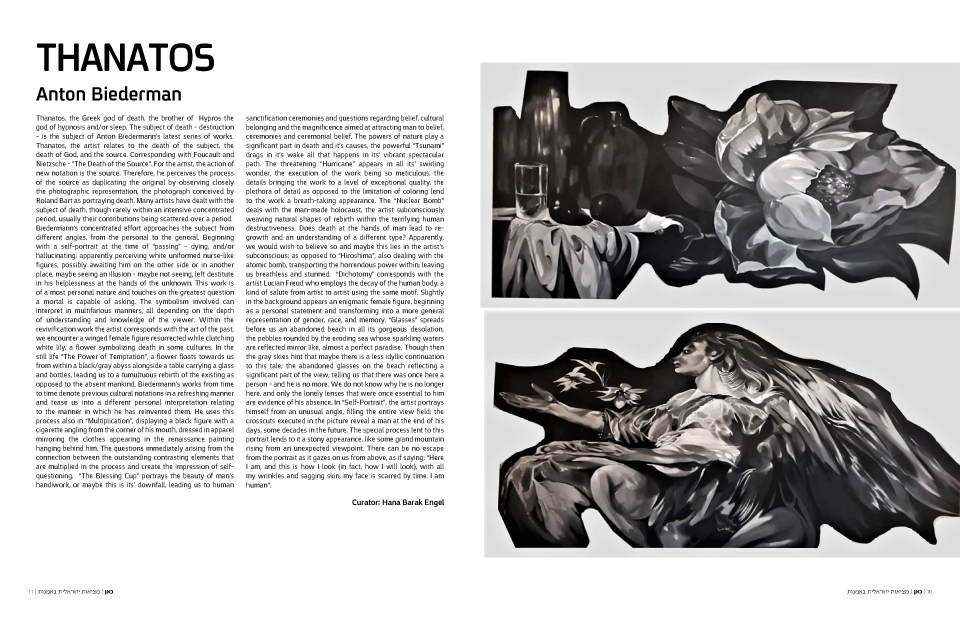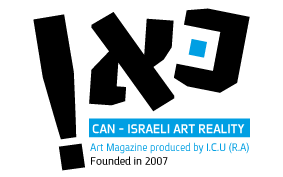Thanatos, the Greek god of death, the brother of Hypros the god of hypnosis and/or sleep. The subject of death – destruction – is the subject of Anton Biedermann’s latest series of works. Thanatos, the artist relates to the death of the subject, the death of God, and the source. Corresponding with Foucault and Nietzsche - "The Death of the Source". For the artist, the action of new notation is the source. Therefore, he perceives the process of the source as duplicating the original by observing closely the photographic representation, the photograph conceived by Roland Bart as portraying death. Many artists have dealt with the subject of death, though rarely within an intensive concentrated period, usually their contributions being scattered over a period.
Biedermann’s concentrated effort approaches the subject from different angles, from the personal to the general. Beginning with a self-portrait at the time of “passing” - dying, and/or hallucinating; apparently perceiving white uniformed nurse-like figures, possibly awaiting him on the other side or in another place, maybe seeing an illusion - maybe not seeing, left destitute in his helplessness at the hands of the unknown. This work is of a most personal nature and touches on the greatest question a mortal is capable of asking. The symbolism involved can interpret in multifarious manners, all depending on the depth of understanding and knowledge of the viewer. Within the revivification work the artist corresponds with the art of the past, we encounter a winged female figure resurrected while clutching white lily, a flower symbolizing death in some cultures. In the still life “The Power of Temptation”, a flower floats towards us from within a black/gray abyss alongside a table carrying a glass and bottles, leading us to a tumultuous rebirth of the existing as opposed to the absent mankind. Biedermann’s works from time to time denote previous cultural notations in a refreshing manner and tease us into a different personal interpretation relating to the manner in which he has reinvented them. He uses this process also in “Multiplication”, displaying a black figure with a cigarette angling from the corner of his mouth, dressed in apparel mirroring the clothes appearing in the renaissance painting hanging behind him. The questions immediately arising from the connection between the outstanding contrasting elements that are multiplied in the process and create the impression of self-questioning. “The Blessing Cup” portrays the beauty of man’s handiwork, or maybe this is its’ downfall, leading us to human sanctification ceremonies and questions regarding belief, cultural belonging and the magnificence aimed at attracting man to belief, ceremonies and ceremonial belief. The powers of nature play a significant part in death and it’s causes, the powerful “Tsunami” drags in it’s wake all that happens in its’ vibrant spectacular path. The threatening “Hurricane” appears in all its’ swirling wonder, the execution of the work being so meticulous, the details bringing the work to a level of exceptional quality, the plethora of detail as opposed to the limitation of coloring lend to the work a breath-taking appearance. The “Nuclear Bomb” deals with the man-made holocaust, the artist subconsciously weaving natural shapes of rebirth within the terrifying human destructiveness. Does death at the hands of man lead to re-growth and an understanding of a different type? Apparently, we would wish to believe so and maybe this lies in the artist’s subconscious; as opposed to “Hiroshima”, also dealing with the atomic bomb, transporting the horrendous power within; leaving us breathless and stunned. “Dichotomy” corresponds with the artist Lucian Freud who employs the decay of the human body, a kind of salute from artist to artist using the same motif. Slightly in the background appears an enigmatic female figure, beginning as a personal statement and transforming into a more general representation of gender, race, and memory. “Glasses” spreads before us an abandoned beach in all its gorgeous desolation, the pebbles rounded by the eroding sea whose sparkling waters are reflected mirror like, almost a perfect paradise. Though then the gray skies hint that maybe there is a less idyllic continuation to this tale; the abandoned glasses on the beach reflecting a significant part of the view, telling us that there was once here a person – and he is no more. We do not know why he is no longer here, and only the lonely lenses that were once essential to him are evidence of his absence. In “Self-Portrait”, the artist portrays himself from an unusual angle, filling the entire view field; the crosscuts executed in the picture reveal a man at the end of his days, some decades in the future. The special process lent to this portrait lends to it a stony appearance, like some grand mountain rising from an unexpected viewpoint. There can be no escape from the portrait as it gazes on us from above, as if saying: “Here I am, and this is how I look (in fact, how I will look), with all my wrinkles and sagging skin, my face is scarred by time. I am human”.
Curator: Hana Barak Engel
Read more

|






